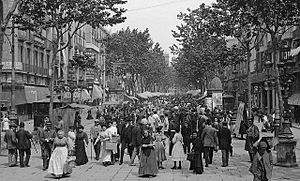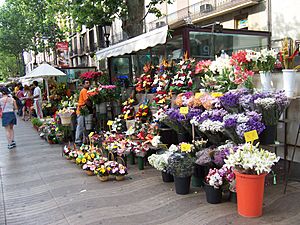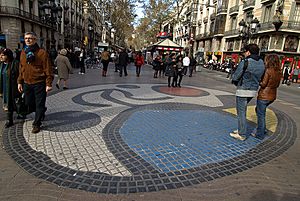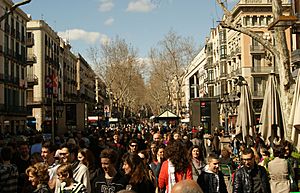La Rambla, Barcelona facts for kids
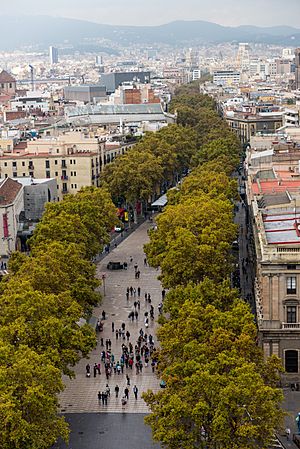
View over the Rambla from the Christopher Columbus monument, with the neighbourhoods of El Raval to the left and Barri Gòtic to the right
|
|
| Length | 1.2 km (0.7 mi) |
|---|---|
| Location | Barcelona, Catalonia, Spain |
| Coordinates | 41°22′53″N 2°10′23″E / 41.38139°N 2.17306°E |
| From | Plaça de Catalunya |
| To | Christopher Columbus Monument |
La Rambla is a famous street in the heart of Barcelona, Spain. It's a long, tree-lined street that's mostly for people walking. It stretches for about 1.2 kilometers (0.75 miles).
This lively street connects two important places: the Plaça de Catalunya (a big square) and the Christopher Columbus Monument near the old port. La Rambla also acts as a border between two interesting neighborhoods: the Barri Gòtic (Gothic Quarter) on one side and El Raval on the other.
La Rambla is very popular, especially with tourists. It can get quite busy, but that's part of its charm! You'll find many outdoor cafes and souvenir shops here. The Spanish poet Federico García Lorca once said that La Rambla was "the only street in the world which I wish would never end."
Contents
Exploring La Rambla
La Rambla is actually made up of several shorter streets, each with its own name. That's why people sometimes call it Les Rambles (which means "The Ramblas" in Catalan). Here are the main parts you'll discover:
- Rambla de Canaletes: This is where you'll find the famous Font de Canaletes fountain. Legend says if you drink from it, you'll return to Barcelona!
- Rambla dels Estudis: This part used to have a university. Today, only the Church of Bethlehem remains from that time.
- Rambla de Sant Josep (or de les Flors): This section is famous for its colorful open-air flower market. It's a beautiful sight!
- Rambla dels Caputxins: This area is home to the grand Liceu opera house.
- Rambla de Santa Mònica: Named after an old convent, this part now has an arts center.
Surrounding Areas
At the northern end of La Rambla is Plaça de Catalunya. This large square is often seen as the very center of Barcelona. It's where the old city meets the newer part called Eixample.
To the east of La Rambla is the Barri Gòtic, also known as the Gothic Quarter. This is the oldest part of Barcelona. It has narrow, winding streets and small squares that connect to La Rambla. One of these squares is the Plaça Reial, a lively place with tall palm trees and unique street lamps designed by the famous architect Antoni Gaudí.
On the west side of La Rambla, you'll find the El Raval quarter. This area was once outside the city walls. Today, it has important buildings like Gaudí's Palau Güell, which is very close to La Rambla.
At the southern end of La Rambla, you'll reach the Christopher Columbus Monument. This monument points towards the Port Vell, Barcelona's old port. The port is now used mostly for pleasure boats. Nearby are the Royal Dockyards (Catalan: Drassanes), which house a museum about naval history in the Mediterranean Sea.
Some areas near La Rambla also share its name but are not considered part of the main street. To the north, the Rambla de Catalunya extends into the Eixample district. To the south, a wooden walkway called the Rambla de Mar goes into the harbor.
History of La Rambla
Long ago, La Rambla was actually a stream bed. It was usually dry, but it helped drain heavy rainwater from the nearby hills. The word "Rambla" comes from an Arabic word meaning "sand" or "wadi" (a dry riverbed). This stream separated the old walled city from the settlements of El Raval.
In 1377, the city walls were expanded to include La Rambla and El Raval. By 1440, the stream was moved outside the new walls, and La Rambla slowly began to become a street.
Over the centuries, La Rambla grew into an important part of Barcelona's city life. It was used for festivals, markets, and even sports. Many religious buildings were also built along the street. These included the Jesuit Bethlehem monastery and college, and the Carmelite St. Joseph's monastery, where the famous La Boqueria market is now.
The first trees were planted along La Rambla in 1703. They were birch trees, later replaced by elm trees. In 1832, acacia trees were planted, and from 1859, the plane trees you see today became common.
Sadly, La Rambla has also seen difficult times. In 2017, a van was deliberately driven down the sidewalk in a terrible attack, causing many deaths and injuries.
What to See on La Rambla
The central part of La Rambla, with its trees, is always busy, day and night. The paving design even looks like rippling water, reminding everyone of its past as a stream.
As you walk along, you'll see many kiosks. Some sell newspapers and souvenirs, while others are filled with beautiful flowers. There are also street performers, artists, and outdoor cafes where you can sit and watch the world go by.
Some special sights on the promenade include a colorful mosaic by the famous artist Joan Miró. You'll also find the Font de Canaletes fountain, which is a popular meeting spot.
Along La Rambla, there are historic buildings like the Palace of the Virreina and the Liceu Theater, where you can watch operas and ballets. The famous La Boqueria market is just off La Rambla. It's a must-see for its huge variety of foods and fresh produce!
A short side street leads to the Plaça Reial (Royal Square). This plaza has palm trees and buildings with arches. It's home to many pubs and restaurants, and on weekends, people gather there to trade stamps and coins.
Culture and Arts
La Rambla is a hub for Barcelona's cultural scene. Here are some key places:
- The Gran Teatre del Liceu, or simply Liceu, is Barcelona's main opera house. It first opened in 1847.
- The Teatre Principal is the oldest theater in Barcelona, dating back to 1568. It has been rebuilt several times over the years.
- The Centre d'Art Santa Mònica is a public museum for modern art. It's located on the Raval side of Rambla de Santa Mònica and often has exhibitions by artists from around the world.
- The Palau de la Virreina is a beautiful Baroque palace that hosts museum exhibitions and cultural events.
You can also find the pavement mosaic by the famous artist Joan Miró in the Pla de l'Os section of La Rambla. It was created in 1971.
Getting Around La Rambla
Most people explore La Rambla by walking along its wide central area. Cars use two narrow roads on either side of the main pedestrian path. No cars are allowed to cross the central walking area.
Barcelona's Metro Line L3 runs underneath La Rambla. There are several stations along the way:
- Catalunya: This station is right next to Plaça Catalunya. It's a big station where you can connect to many other metro and train lines.
- Liceu: Located in front of the Liceu opera house, this station serves the middle part of La Rambla.
- Drassanes: This station is near the port and the Centre d'Art Santa Mònica.
Several Barcelona bus lines also run along the service roads next to La Rambla during the day and at night.
Future Plans for La Rambla
In 2017, the city of Barcelona approved a plan to update La Rambla. The goal is to give it a new look and make it even better for both locals and visitors. Construction is expected to start in late 2022.
The plan includes making more space for people to walk by reducing the number of car lanes. Traffic will also be limited mostly to service vehicles and people who live in the area. The main idea is to create a "green space" that feels more welcoming and enjoyable for everyone. The project has a budget of about €45 million and will be completed in stages.
See also
 In Spanish: La Rambla para niños
In Spanish: La Rambla para niños
- Street names in Barcelona
- Urban planning of Barcelona




